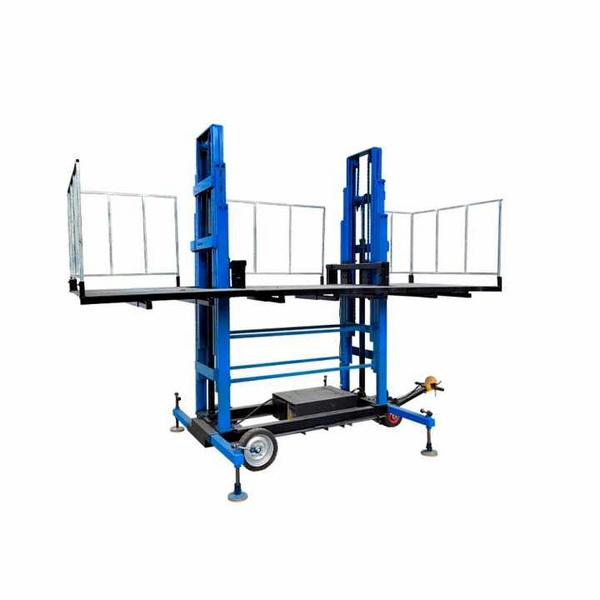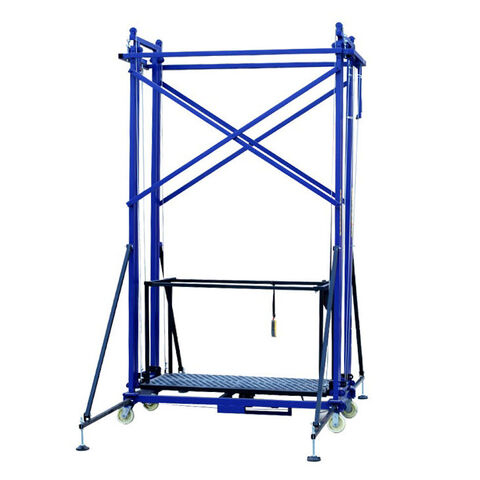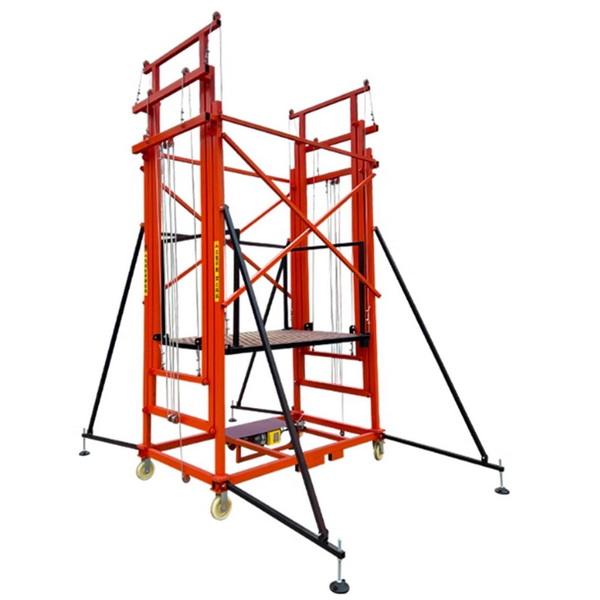Content Menu
● Understanding Hydraulic Scaffolding Systems
● Key Components of a Hydraulic Scaffolding System
● Advantages of Hydraulic Scaffolding Systems
>> 1. Enhanced Safety
>> 2. Increased Productivity
>> 3. Cost-Effectiveness
>> 4. Versatility and Adaptability
● Applications of Hydraulic Scaffolding Systems
>> 1. High-Rise Construction
>> 2. Bridge Maintenance and Repair
>> 3. Industrial Maintenance
>> 4. Shipbuilding and Repair
● Implementation of Hydraulic Scaffolding Systems
>> Planning and Design
>> Installation Process
>> Training and Certification
● Safety Considerations
● Environmental Impact
● Future Trends in Hydraulic Scaffolding
● Case Studies
>> 1. The Shard, London
>> 2. Sydney Harbour Bridge Maintenance
● Conclusion
● FAQ
>> 1. How much weight can a hydraulic scaffolding system support?
>> 2. Are hydraulic scaffolding systems suitable for indoor use?
>> 3. How do hydraulic scaffolding systems perform in extreme weather conditions?
>> 4. What is the lifespan of a hydraulic scaffolding system?
>> 5. Can hydraulic scaffolding systems be customized for specific project needs?
In the ever-evolving world of construction, innovative technologies continue to reshape the industry landscape. One such groundbreaking development is the hydraulic scaffolding system, a game-changer in terms of efficiency, safety, and versatility. This article delves into the intricacies of hydraulic scaffolding systems, exploring their components, benefits, and applications in modern construction projects.

Understanding Hydraulic Scaffolding Systems
A hydraulic scaffolding system is an advanced form of temporary work platform that utilizes hydraulic power to raise and lower the entire scaffold structure. Unlike traditional scaffolding that requires manual assembly and disassembly, hydraulic scaffolding can be adjusted vertically with the push of a button, dramatically reducing setup time and labor costs.
Key Components of a Hydraulic Scaffolding System
1. Hydraulic Cylinders: These are the core of the system, providing the lifting power.
2. Power Unit: Usually consisting of an electric motor and hydraulic pump.
3. Control Panel: Allows operators to manage the scaffold's height precisely.
4. Safety Locks: Mechanical locks that engage automatically to prevent accidental lowering.
5. Platforms: Typically made of sturdy materials like steel or aluminum.
6. Guardrails: Essential safety features that prevent falls.
Advantages of Hydraulic Scaffolding Systems
1. Enhanced Safety
Safety is paramount in construction, and hydraulic scaffolding systems offer significant improvements in this area. The ability to adjust the height of the entire platform from ground level reduces the risk of falls during assembly and disassembly. Additionally, the stable and level platform provided by hydraulic systems minimizes the chances of accidents due to uneven surfaces.
2. Increased Productivity
One of the most significant advantages of hydraulic scaffolding systems is the dramatic increase in productivity they offer. Traditional scaffolding can take hours or even days to erect and dismantle, especially for tall structures. In contrast, hydraulic scaffolding can be set up and adjusted in a matter of minutes, allowing work to begin almost immediately.
Time Savings Comparison:
| Task | Traditional Scaffolding | Hydraulic Scaffolding |
| Setup | 4-8 hours | 30-60 minutes |
| Height Adjustment | 1-2 hours | 5-10 minutes |
| Dismantling | 3-6 hours | 20-40 minutes |
3. Cost-Effectiveness
While the initial investment in a hydraulic scaffolding system may be higher than traditional scaffolding, the long-term cost savings are substantial. Reduced labor hours for setup and dismantling, decreased downtime between tasks, and the ability to use the same system across multiple projects all contribute to significant cost reductions over time.
4. Versatility and Adaptability
Hydraulic scaffolding systems are incredibly versatile, capable of adapting to various construction scenarios. They can be used for both interior and exterior work, and their adjustable height makes them suitable for projects ranging from single-story buildings to high-rise structures.

Applications of Hydraulic Scaffolding Systems
1. High-Rise Construction
In high-rise construction, hydraulic scaffolding systems truly shine. The ability to quickly adjust the platform height allows workers to access different levels of the building without the need for constant reassembly. This is particularly beneficial for tasks such as facade installation, window fitting, and exterior painting.
2. Bridge Maintenance and Repair
Bridges present unique challenges for scaffolding, often requiring access to hard-to-reach areas over water or traffic. Hydraulic scaffolding systems can be designed to provide stable platforms that can be easily adjusted to reach various parts of the bridge structure, improving both safety and efficiency.
3. Industrial Maintenance
In industrial settings such as power plants, refineries, and manufacturing facilities, hydraulic scaffolding systems offer the flexibility needed for maintenance and repair work. The quick setup and adjustment capabilities minimize downtime, which is crucial in these environments where every minute of stoppage can be costly.
4. Shipbuilding and Repair
The shipbuilding industry has embraced hydraulic scaffolding systems due to their ability to conform to the curved surfaces of ship hulls. These systems can be adjusted to provide access to different areas of the vessel, from the keel to the upper decks, without the need for multiple scaffold setups.
Implementation of Hydraulic Scaffolding Systems
Planning and Design
Implementing a hydraulic scaffolding system begins with careful planning and design. Engineers must consider factors such as:
- The maximum height required
- The total load capacity needed
- The specific tasks to be performed
- Any site-specific challenges or restrictions
Custom designs may be necessary for complex projects or unique architectural features.
Installation Process
1. Site Preparation: Ensure a level and stable foundation.
2. Base Assembly: Set up the base frame and hydraulic cylinders.
3. Platform Installation: Secure the work platforms to the lifting mechanism.
4. Safety System Setup: Install guardrails, toe boards, and access ladders.
5. Power Connection: Connect the hydraulic power unit and control systems.
6. Testing: Conduct thorough testing of all components before use.
Training and Certification
Proper training is essential for the safe and effective use of hydraulic scaffolding systems. Operators should be certified in:
- System operation and control
- Safety procedures and emergency protocols
- Load management and distribution
- Maintenance and troubleshooting
Regular refresher courses and updates on new features or regulations are also important.
Safety Considerations
While hydraulic scaffolding systems offer improved safety features, proper precautions are still necessary:
- Regular Inspections: Daily checks of all components, especially hydraulic systems.
- Load Management: Strict adherence to weight limits and proper distribution of materials.
- Weather Monitoring: Adjusting operations based on wind speeds and other weather conditions.
- Fall Protection: Use of personal fall arrest systems when required.
- Emergency Procedures: Clear protocols for system failures or accidents.
Environmental Impact
Hydraulic scaffolding systems can contribute to more sustainable construction practices:
- Reduced Material Waste: Less need for disposable scaffolding components.
- Energy Efficiency: Electric-powered hydraulic systems can be more energy-efficient than manual labor.
- Noise Reduction: Quieter operation compared to traditional scaffolding assembly.
- Minimal Site Disruption: Smaller footprint and quicker setup reduce overall site impact.
Future Trends in Hydraulic Scaffolding
The future of hydraulic scaffolding systems looks promising, with several emerging trends:
1. Integration with BIM: Building Information Modeling integration for better project coordination.
2. Smart Sensors: Real-time monitoring of load distribution and structural integrity.
3. Automated Adjustment: AI-driven systems that adjust height based on work progress.
4. Modular Designs: Increased flexibility for complex architectural shapes.
5. Eco-Friendly Materials: Development of sustainable and recyclable components.
Case Studies
1. The Shard, London
The construction of The Shard, one of Europe's tallest buildings, utilized hydraulic scaffolding systems to overcome the challenges of working at extreme heights. The system allowed for quick adjustments as the building rose, significantly reducing construction time.
2. Sydney Harbour Bridge Maintenance
Ongoing maintenance of the iconic Sydney Harbour Bridge has been facilitated by custom hydraulic scaffolding systems that can adapt to the bridge's unique shape and provide safe access for workers without disrupting traffic.
Conclusion
Hydraulic scaffolding systems represent a significant leap forward in construction technology. By offering enhanced safety, increased productivity, cost-effectiveness, and versatility, these systems are transforming the way construction projects are approached and executed. As the technology continues to evolve, we can expect even greater innovations that will further improve construction efficiency and safety.
The adoption of hydraulic scaffolding systems is not just a trend but a fundamental shift in construction methodology. As more companies recognize the benefits, we are likely to see these systems become the standard for a wide range of construction and maintenance projects. The future of construction is here, and it's powered by hydraulics.

FAQ
1. How much weight can a hydraulic scaffolding system support?
Hydraulic scaffolding systems are designed to support substantial loads, typically ranging from 25 to 75 pounds per square foot, depending on the specific model and configuration. Some heavy-duty systems can support even greater weights. It's crucial to consult the manufacturer's specifications and adhere to load limits strictly.
2. Are hydraulic scaffolding systems suitable for indoor use?
Yes, hydraulic scaffolding systems are suitable for indoor use, especially in large interior spaces like atriums, theaters, or industrial facilities. Many systems are designed with non-marking wheels and electric power units that produce no emissions, making them ideal for indoor applications where air quality and floor protection are concerns.
3. How do hydraulic scaffolding systems perform in extreme weather conditions?
Hydraulic scaffolding systems are engineered to withstand various weather conditions, but precautions must be taken. In high winds, the platform should be lowered to its base position. For extreme cold, special hydraulic fluids may be required. Regular maintenance and weather-appropriate operational procedures ensure safe use in challenging environments.
4. What is the lifespan of a hydraulic scaffolding system?
With proper maintenance and care, a high-quality hydraulic scaffolding system can last 15-20 years or more. Regular inspections, timely repairs, and adherence to manufacturer guidelines for use and storage are key to maximizing the lifespan of these systems.
5. Can hydraulic scaffolding systems be customized for specific project needs?
Absolutely. Many manufacturers offer customization options to meet specific project requirements. This can include custom platform sizes, specialized attachments for unique architectural features, or integration with other construction equipment. Working closely with the manufacturer or a scaffolding engineer can result in tailored solutions for even the most challenging projects.






















